Abstract
In this study, we use an analytical method tailored for the in-depth exploration of coupled nonlinear partial differential equations (NLPDEs), with a primary focus on the dynamics of solitons. Traditional methods are quite effective for solving individual nonlinear partial differential equations (NLPDEs). However, their performance diminishes notably when addressing systems of coupled NLPDEs. This decline in effectiveness is mainly due to the complex interaction terms that arise in these coupled systems. Commonly, researchers have attempted to simplify coupled NLPDEs into single equations by imposing proportional relationships between various solutions. Unfortunately, this simplification often leads to a significant deviation from the true physical phenomena that these equations aim to describe. Our approach is distinctively advantageous in its straightforwardness and precision, offering a clearer and more insightful analytical perspective for examining coupled NLPDEs. It is capable of concurrently facilitating the propagation of different soliton types in two distinct systems through a single process. It also supports the spontaneous emergence of similar solitons in both systems with minimal restrictions. It has been extensively used to investigate a wide array of new coupled progressive solitons in birefringent fibers, specifically for complex Ginzburg–Landau Equations (CGLEs) involving Hamiltonian perturbations and Kerr law nonlinearity. The resulting solitons, with comprehensive 2D and 3D visualizations, showcase a variety of coupled soliton configurations, including several that are unprecedented in the field. This innovative approach not only addresses a significant gap in existing methodologies but also broadens the horizons for future research in optical communications and related disciplines.
Keywords:
W-shaped-W-shaped solitons; W-shaped-bright solitons; W-shaped-dark solitons; complex Ginzburg–Landau equations; Hamiltonian perturbations; Kerr law nonlinearity MSC:
35G20; 35G50
1. Introduction
Nonlinear partial differential equations (NPLDEs) have become a topic in a wide field of sciences due to the vital role they play as the mathematical models describing a wide range of phenomena occurring in fluids, plasmas, chemistry, biology and engineering [1,2,3,4,5,6,7,8,9]. As such, they have attracted many physicists and mathematicians who are interested in building powerful mathematical tools that might help reveal its analytical solutions. The latter are powerful instruments that reveal information to better understand the nonlinear physical mechanism behind these NLPDEs and by ricochet behind these nonlinear phenomena [10]. Among these solutions, solitons have positioned themselves as the most significant and have received increasing applications of experimental, numerical and theoretical interests [11,12,13]. Their localized characteristics and exceptional stability during propagation and interaction [14] enable them to effectively transmit digital signals over extended distances. These attributes enhance their potential use in designing fiber optic amplifiers, solitary wave communication systems, and optical compressors [15,16]. Solitons are commonly employed in optical fiber communications and the design of devices such as optical superchargers. According to [17], the formation of solitons in optical fibers is influenced by several factors, including group velocity dispersion (GVD), which can be in either a normal or anomalous regime, self-phase modulation (SPM), self-steepening (SS), Kerr nonlinearity, and cross-phase modulation (XPM). These parameters play crucial roles and can significantly impact the interplay between nonlinear effects and dispersion terms (see [17] and associated references). The nonlinear Schrödinger equation (NLSE) is a well-known NLPDE used to study solitons in nonlinear optical fibers, typically for a scalar field. A crucial aspect to consider is that, in practical optical fibers, no mode is purely single due to birefringence, which can lead to pulse splitting within the fiber. Single-mode fibers, in particular, often exhibit bimodal behavior [18,19]. To more accurately model solitons in such environments, the primary governing NLSE is often extended to vector-coupled NLSEs.
Recently, vector solitons in many coupled NLSEs were investigated in [20,21,22,23,24]; surprisingly, in some of these works, the obtained exact solutions were all similar in both lines. A throughout examination of the procedure used by their authors revealed a serious drawback in the way it was carried out within the coupled NLSE framework. In fact, we should note that the effective application of advanced techniques to single NLPDEs often showcases significant success. However, their effectiveness diminishes when dealing with coupled NLPDEs. The added complexity from interaction terms in these coupled equations makes it very difficult to find exact solutions. Despite significant research into exact traveling wave and soliton solutions, this challenge persists. To address these difficulties, researchers have tried simplifying coupled equations into single ones by imposing strict constraints [25,26,27,28,29]. Although this approach is innovative, it alters the fundamental nature of the problem and the physical phenomena represented by the coupled equations. The extensive and sometimes counterintuitive constraints needed for this transformation restrict the practicality of the solutions, revealing a gap in current methodologies. Additionally, the assumption that ( represents the wave function in the first line, and represents the wave function in the second line; with and denoting the amplitude and phase components of the wave, respectively, and being a real constant) only allows the propagation of same types of nonlinear waves on the two lines [30,31]. In a similar vein, Samir et al. [32] investigated solitons in birefringent fibers by applying a modified extended direct algebraic method to complex Ginzburg–Landau equations (CGLEs) with Hamiltonian perturbations and Kerr law nonlinearity using similar assumptions. Their method, however, only permits the propagation of identical wave types in both channels, precluding the possibility of different wave types in each line. In our research, we propose an innovative strategy to address and mitigate the challenges inherent in solving coupled NLPDEs.
This novel approach, recently introduced by one of us in [30,31], builds upon the exponential function method originally developed by He and Wu [33] for solving single NLPDEs. We have adapted and expanded this methodology to manage the complexities of coupled NLPDEs more effectively. Our technique is characterized by its simplicity, efficiency, and conciseness, making it particularly well-suited for addressing the intricate nature of coupled NLPDEs. The novelty of our method lies in its dual capability. First, it allows for the creation and propagation of a diverse range of solutions across two lines, including some coupled solutions that are rarely documented in current literature, thereby addressing a significant gap in the field. Second, it enables the propagation of identical types of solutions in both lines, with these solutions emerging more naturally and with fewer constraints compared to existing methods. This versatility enhances the method’s practical utility. Moreover, our approach offers precise control over the solutions it generates, overcoming a common issue in previous methods where mathematical singularities limited real-world applicability. This precision is particularly advantageous for practical applications such as soliton transmission in dual channels, where controlled and predictable outcomes are crucial. Another notable feature of our method is its adaptability to various computational tools, including Maple, Matlab, and Mathematica. This compatibility ensures that our method can be easily employed by researchers and practitioners to develop complex solutions, such as W-shaped solitons, which have significant applications in optics and telecommunications. However, our method shows diminished capability when addressing coupled higher-order dispersion differential equations, particularly those involving quintic or higher-order derivatives.
In a broader context, both integrable and non-integrable NLPDEs play significant roles in various fields such as fluid dynamics, physics, and engineering, where they help model complex phenomena. Both types can exhibit intricate behaviors, including wave propagation, shock waves, and solitons. Their study provides valuable insights into the dynamics of systems across multiple disciplines. Integrable NLPDEs often come with systematic solution methods like the inverse scattering transform and Hirota’s direct method. These techniques allow for the construction of N soliton solutions that interact in a predictable manner. Typically, these equations possess special algebraic structures, such as bi-Hamiltonian frameworks, infinite-dimensional symmetry groups, or Lax pairs, which facilitate the derivation of solutions. In contrast, non-integrable NLPDEs not only lack the elegant properties found in integrable NLPDEs, but they also do not have systematic methods for finding solutions. Standard analytical techniques may fall short, and solutions are frequently explored through approximations or perturbative approaches, while non-integrable equations can exhibit solitary wave solutions, they usually support at most N=2 soliton solutions, which are often unstable or interact unpredictably. The interactions among solitary waves in non-integrable systems can lead to complex phenomena, such as the emergence of new waves, variations in amplitude, and turbulent behavior. Importantly, solitons may not revert to their original state after interaction. This underscores the significance of the method developed in this study, which is specifically designed for a class of non-integrable NLPDEs. Our approach not only addresses the challenges posed by non-integrable systems but also has the potential to solve integrable coupled equations found in recent literature [34,35,36,37]. In essence, our method is versatile and robust, providing a pathway to tackle both integrable and non-integrable scenarios effectively.
This paper aims to analytically demonstrate the effectiveness of the aforementioned method in uncovering the formation and dynamics of a diverse range of optical solitons in two-component birefringent fibers. Specifically, we focus on modified complex Ginzburg–Landau equations (CGLEs) with Hamiltonian perturbations and Kerr law nonlinearity, which result in complex equation systems. This approach extends the coupled equations introduced by Samir et al. [32].
The current work is structured as follows: The birefringent fibers for modified CGLEs with Hamiltonian perturbations and Kerr law nonlinearity are formulated in Section 2. In Section 3, we present the mathematical analysis, where we assumed the propagating wave solutions. In Section 4, we apply a new approach to ensure the propagation of W-shaped-like soliton combined with other types of soliton solutions in the two channels. Section 5 presents the results and discussion, while Section 6 is dedicated to the conclusions and final observations.
2. Governing Model
The complex Ginzburg–Landau equations with Hamiltonian perturbations and Kerr law nonlinearity for birefringent fibers, as proposed by Samir et al. [32], need to be adjusted to the coupled nonlinear equations described as follows [38]:
where and are the solutions, and and and are constants. Here, and the roles of these constants have been previously described in [32]. The variables x and t are the independent variables representing spatial and temporal components, respectively, while and are complex-valued functions.
3. Mathematical Analysis
We assume the propagating wave solutions to the system of (1) and (2) in the form
and
where and are nonzero constants to be determined. Here, and are real field profiles, with and representing the speed, frequency, soliton wave number, and soliton phase, respectively. Note that is nonzero, indicating that the pulses have an initial phase at and . The corresponding intensities of the propagating waves are given by and . By substituting Equations (3) and (4) into (1) and (2) and separating the imaginary and real parts, we obtain the following imaginary parts [32].
In this context, k and c represent the wave frequency and speed, respectively. Equations (5)–(8) describe the evolution of the field amplitudes and in the coupled optical system. It is important to note that finding exact solutions for these evolutionary equations is challenging due to the presence of complex linear, nonlinear, and nonlinear dispersion coupling terms in both equations. Determining closed-form solutions for these four coupled amplitude equations is of significant interest, as such analytical solutions can provide a deeper understanding of how optical pulses propagate through birefringent fibers in the context of CGLEs with Hamiltonian perturbations and Kerr law nonlinearity.
4. Method for Searching for Propagation of W-Shaped-like Solitons Combined with Other Families of Solitons
In [32], the authors limited their solutions to the form for the system they examined, introducing additional constraints to Equations (5)–(8). These constraints led to the simplification of the coupled evolution equations into a single equation, which in turn reduced the coupled Equations (1) and (2) to a single nonlinear partial differential equation. Our objective is to enhance the analytical investigation of coupled NLPDEs by proposing a more comprehensive approach. To broaden the range of solutions, we will impose no restrictions on and and assume the following forms for these functions:
where and are considered to be real functions. Using symbolic computation, we propose a suitable scheme based on specific choices for and . Our aim is to identify progressive solitonic solutions, and thus we introduce the following selections for these functions.
where , and are real constants to be determined. By substituting Equations (9) and (10) into (5) to (8), we obtain a system of algebraic equations, which are then solved as follows:
−Set 1
The following three equations are solved in terms of the expressions of the parameters and leaving and arbitrary.
This solution set exists under the following constraints:
−Set 2
The above expression of c is substituted into the following two equations and the obtained equations are then solved for the parameters and while and are free parameters.
The constraints for the existence of the above solution set are given below:
Sets 1 and 2 lead to the following progressive solitonic-type solutions:
where and and are given by (11) or (14). We present this family of solutions in Figure 1, Figure 2, Figure 3, Figure 4, Figure 5 and Figure 6, applying the parameter constraints specified in (14). The retrieved coupled progressive solitons include: W-shaped−W-shaped solitons, dark−W-shaped solitons, bright−W-shaped solitons, bright−bright solitons, dark−bright solitons, and dark−dark solitons. It is noteworthy that (17) introduces new classes of solutions for (9) and (10).
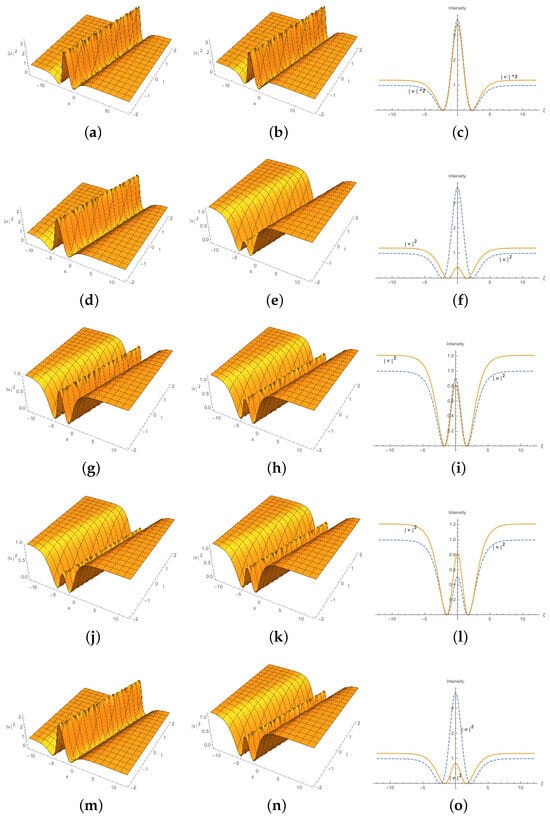
Figure 1.
Evolution of progressive solitonic solutions for (1) and (2) represented by the solutions (17) under the conditions of set 1 with coefficient values and the arbitrary parameters are chosen to be for the W- shaped−W-shaped-like soliton solutions (a–c). for the W-shaped−W-shaped-like soliton solutions (d–f). for the W-shaped−W-shaped-like soliton solutions (g–i). for the W-shaped−W-shaped-like soliton solutions (j–l). Finally, for the W-shaped−W-shaped-like soliton solutions (m–o).
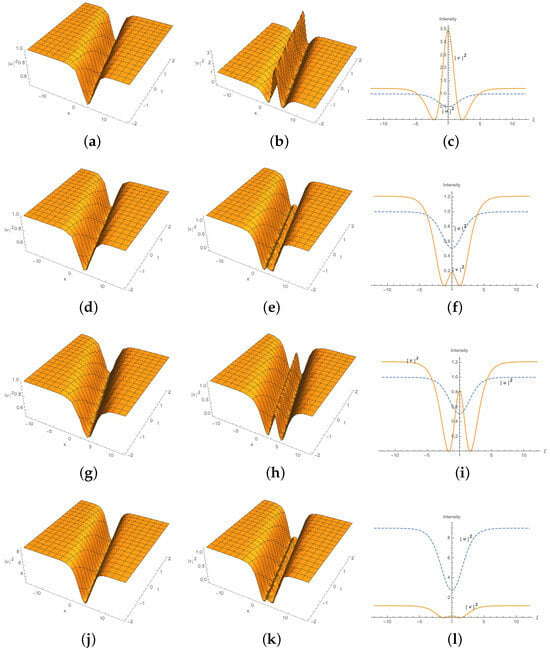
Figure 2.
Evolution of progressive solitonic solutions for (1) and (2) represented by the solutions (17) under the conditions of set 1 with coefficient values and the arbitrary parameters are chosen to be for the dark−W shaped soliton solutions (a–c). for the dark−W-shaped soliton solutions (d–f). for the dark−W-shaped soliton solutions (g–i). Finally, for the dark−W-shaped soliton solutions (j–l).
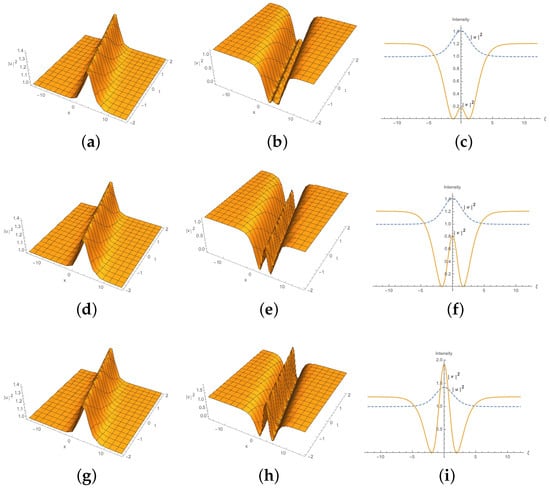
Figure 3.
Evolution of progressive solitonic solutions for (1) and (2) represented by the solutions (17) under the conditions of set 1 with coefficient values and the arbitrary parameters are chosen to be for the bright−W-shaped soliton solutions (a–c). for the bright−W-shaped soliton solutions (d–f). Finally, for the bright−W-shaped soliton solutions (g–i).
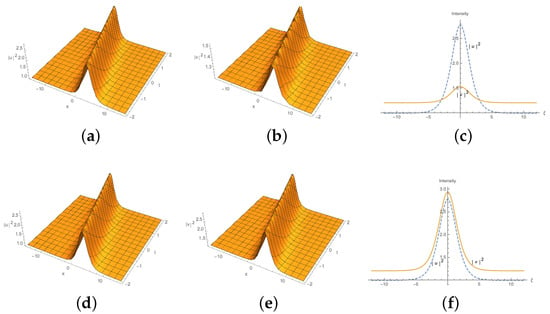
Figure 4.
Evolution of progressive solitonic solutions for (1) and (2) represented by the solutions (17) under the conditions of set 1 with coefficient values and the arbitrary parameters are chosen to be for the bright−bright soliton solutions (a–c). Finally, for the bright−bright soliton solutions (d–f).
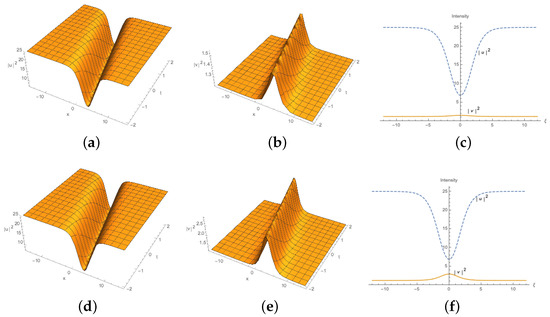
Figure 5.
Evolution of progressive solitonic solutions for (1) and (2) represented by the solutions (17) under the conditions of set 1 with coefficient values and the arbitrary parameters are chosen to be for the dark−bright soliton solutions (a–c). Finally, for the dark−bright soliton solutions (d–f).
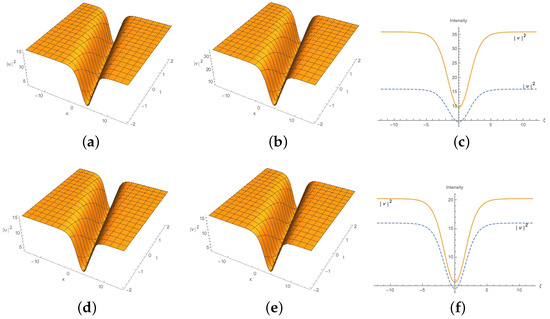
−Set 3
After replacing c into the following four equations, the obtained equations are solved in terms of the expressions of the parameters and leaving and arbitrary.
The above-mentioned solution set 3 exists under the following constraints:
−Set 4
The expression of c above is substituted into the following three equations, the obtained equations are then solved for the expressions of the parameters and while and are arbitrary parameters.
Solution set 4 exists under the following constraints:
Sets 3 and 4 lead to the following progressive solitonic-type solutions:
where and and are given by (18) or (21).
−Set 5
After replacing the expression of c above into the following two equations and then solving the obtained equations, we obtained the parameters and in terms of which with m and n are the free parameters.
The following relations are the constraints to be satisfied for the existence of the solution set 5.
−Set 6
and n are the arbitrary parameters.
Solution sets 5 and 6 generate the following progressive solitonic-type solutions:
where and and are given by (25), or (28). We illustrate this family of solutions in Figure 7, Figure 8 and Figure 9 using constraints on the parameters given in (27). We were able to retrieve the following coupled progressive solitons: kink−kink solitons, kink−dark-kink solitons, dark-kink−dark-kink-like solitons, anti-kink−anti-kink solitons, anti-kink−dark-anti-kink solitons, dark-anti-kink−dark-anti-kink solitons, kink−anti-kink solitons, kink−dark-anti-kink solitons, kink-dark−anti-kink solitons, and kink-dark−dark-anti-kink solitons. We note that (30) provides new classes of solutions for (1) and (2).
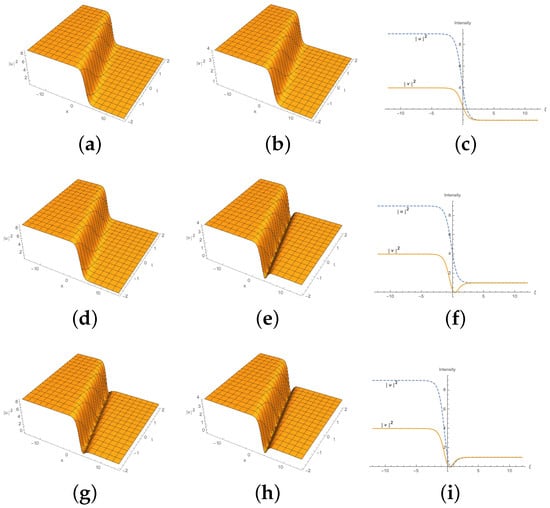
Figure 7.
Evolution of progressive solitonic solutions for (1) and (2) represented by the solutions (30) under the conditions of set 5 with coefficient values The arbitrary parameters are and is set to 1. for the kink−kink soliton solutions (a–c), while for kink−kink dark soliton solutions (d–f), finally, for the kink dark−kink dark soliton solutions (g–i).
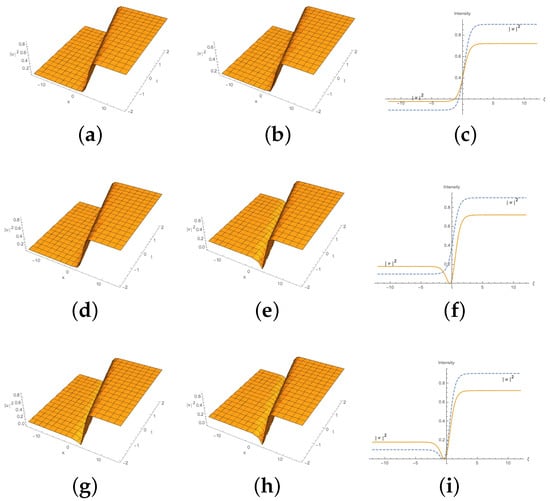
Figure 8.
Evolution of progressive solitonic solutions for (1) and (2) represented by the solutions (30) under the conditions of set 5 with coefficient values The arbitrary parameters are and is set to 1. for the anti-kink−anti-kink soliton solutions (a–c), while for the anti-kink−dark anti-kink soliton solutions (d–f), finally, for the dark anti-kink−dark anti-kink soliton solutions (g–i).
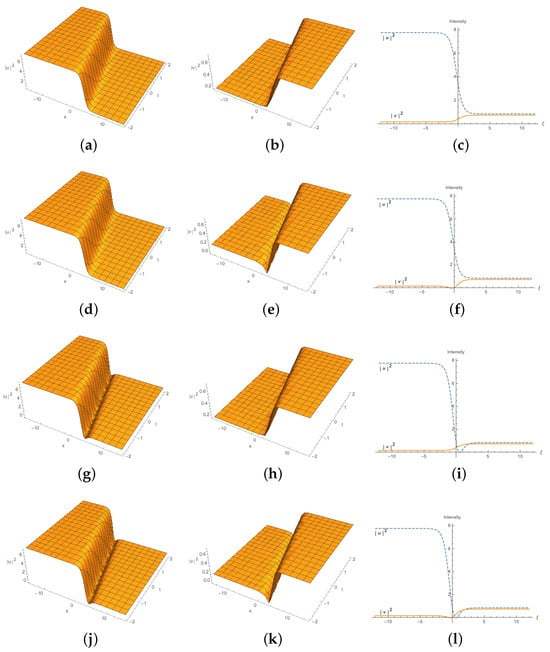
Figure 9.
Evolution of progressive solitonic solutions for (1) and (2) represented by the solutions (30) under the conditions of set 5 with coefficient values The arbitrary parameters are and is set to 1. for the kink−anti-kink soliton solutions (a–c), while for the kink−dark anti-kink soliton solutions (d–f). for the kink−dark anti-kink soliton solutions (g–i). Finally, for the kink dark−dark anti-kink soliton solutions (j–l).
−Set 7
Here, and m are arbitrary parameters.
−Set 8
Here, and m are the arbitrary parameters. The solution sets 7 and 8 generate the following progressive solitonic solitons:
where and and are given by (31) or (33). It is important to note that (35) introduces new classes of solutions for Equations (1) and (2).
−Set 9
Here, and m are the arbitrary parameters.
−Set 10
Here, and m are arbitrary parameters.
Solution sets 9 and 10 generate the following progressive solitonic-type solutions:
where and and are given by (36), or (38). It is important to note that (39) introduces new classes of solutions for Equations (1) and (2).
−Set 11
Here, is an arbitrary parameter.
Solution set 11 generates the following progressive solitonic-type solutions:
where and and are given by (40). It is important to note that (40) introduces new classes of solutions for Equations (1) and (2).
−Set 12
Here, and are the arbitrary parameters.
−Set 13
Here, and n are the arbitrary parameters.
Solution sets 12 and 13 generate the following progressive solitonic-type solutions:
where and and are given by (43) or (45). We illustrate this set of solutions in Figure 10, applying the parameter constraints specified in (44). The resulting coupled progressive solitons include dark−kink solitons, dark−anti-kink solitons, dark−kink–dark solitons, and dark−dark–anti-kink solitons. It is noteworthy that (47) reveals new classes of solutions for Equations (1) and (2).
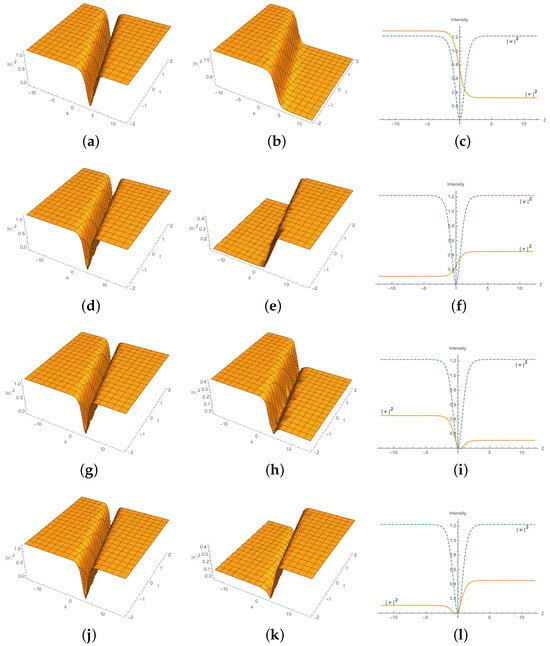
Figure 10.
Evolution of progressive solitonic solutions for (1) and (2) represented by the solutions (47) under the conditions of set 13 with coefficient values The arbitrary parameters are and is set to 1. for the dark−kink soliton solutions (a–c), while for the dark–anti-kink soliton solutions (d–f), for the dark−kink dark soliton solutions (g–i). Finally, for the dark−dark anti-kink soliton solutions (j–l).
−Set 14
Here, is an arbitrary parameter.
−Set 15
Here and c are arbitrary parameters.
Solution sets 14 and 15 generate the following progressive solitonic-type solutions
where and and are given by (48). It should be noted that (51) introduces new classes of solutions for Equations (1) and (2).
−Set 16
Here is an arbitrary parameter.
Solution set 16 generates the following progressive solitonic-type solutions:
where and and are given by (52). It should be noted that (54) introduces new classes of solutions for Equations (1) and (2).
−Set 17
Here is arbitrary parameters.
Solution set 17 generates the following progressive solitonic-type solutions
where and and are given by (55). It should be noted that (57) introduces new classes of solutions for Equations (1) and (2).
−Set 18
Here, and are the arbitrary parameters.
5. Results and Discussion
In this study, coupled complex Ginzburg–Landau equations with Hamiltonian perturbations and Kerr law nonlinearity are effectively analyzed using new ansatzes and Mathematica. As previously noted, addressing multicomponent equations with numerous coupling terms presents significant mathematical challenges. To address this, some researchers have proposed reducing the problem from multicomponent to single-component equations by applying several constraints. It is important to highlight that Figure 1, Figure 2, Figure 3, Figure 4, Figure 5 and Figure 6, which illustrate various solutions for (1) and (2), were obtained from set 1 and correspond to the following progressive soliton solutions. via (17). These new rational soliton solutions, expressed in terms of the cosh function for (1) and (2), propagate on a non-zero background. Specifically, , and for . Thus, and characterize the strength of the background on which these progressive nonlinear waves travel.
To demonstrate the development of progressive solitonic solutions for Equations (1) and (2), as given by the solutions in (17) and the set 1 outlined in (11)–(13), we set the following coefficients as follows:
The other coefficients will be identified based on the constraints provided in (13) and the parameters specified in (11) and (12).
The wave velocity and frequency can be calculated using relation (11), yielding and for Figure 1 and Figure 6, and and for Figure 7 and Figure 10. The initial position for the progressive waves is set to 0.75. Analyzing the graphical representations of Equations (1) and (2) under set 1, it is evident that Figure 1, Figure 2, Figure 3, Figure 4, Figure 5 and Figure 6 depict various coupled solitons with different energy levels, arranged in three subgraphs. The first two subgraphs provide a 3D perspective, while the third shows a 2D view of the solutions. The images reveal that the solutions exhibit a range of soliton features, including W-shaped−W-shaped, dark −W-shaped, bright−dark, bright−bright, bright−W-shaped, and dark−dark configurations.
For the new solutions in set 5, it appears that at at , while at , at . To demonstrate the development of progressive solitonic solutions for Equations (1) and (2), as given by the solutions in (30) and the set 5 outlined in (25)–(27), we set the following coefficients as follows:
. Only the coefficients and will vary. The remaining coefficients will be determined based on the constraints given in (27) and the parameters specified in (25) and (26), while and are arbitrary. Figure 7, Figure 8 and Figure 9 show pairs of kink−kink, kink−kink dark-like, kink dark−kink dark-like, anti-kink−anti-kink, and kink−anti-kink configurations. Figure 10 illustrates pairs of dark−kink and dark−anti-kink solitons.
A notable characteristic of the observed structures is that, despite their varying functional forms, they propagate with a velocity c and a wave number k hat are uniquely determined by the coefficients of the nonlinear partial differential equations (NLPDEs). These coefficients can be manipulated to control effectively the velocity and the wave frequency of the structures. Hence, their velocity can be significantly reduced, enabling slow-light pulse propagation through this control. This finding could be useful in developing slow-light systems [39]. It is important to highlight that all obtained solutions and their corresponding constraints have been rigorously verified using Mathematica by substituting them back into the original Equations (1) and (2). The theoretical results are further supported by the numerical simulations shown in Figure 1, Figure 2, Figure 3, Figure 4, Figure 5, Figure 6, Figure 7, Figure 8, Figure 9 and Figure 10, which confirm the accuracy of the solutions. However, the numerical simulations, based on the chosen coefficient values for Figure 1, Figure 2, Figure 3, Figure 4, Figure 5, Figure 6, Figure 7, Figure 8, Figure 9 and Figure 10, have resulted in the error data presented in Table 1.
6. Conclusions
In this study, the dynamics of wave propagation in polarization-preserving birefringent fibers have been successfully analyzed using a new method. This analysis focuses on the complex modified Ginzburg–Landau equations with Hamiltonian perturbation and Kerr law nonlinearity. Our analytical approach marks a significant advancement in the study of coupled nonlinear partial differential Equations (NLPDEs), while traditional methods are adept at managing single NLPDEs, they often struggle with coupled systems. Our method effectively navigates the complex interaction terms within these coupled equations. Previous techniques, which typically sought to reduce coupled equations to a single form through strict constraints, often compromised the true nature of the physical phenomena involved. In contrast, our approach provides a more intuitive, accurate, and comprehensive analysis of coupled NLPDEs. It has facilitated the development of a wide range of new soliton solutions for the coupled equations studied. This diverse set of coupled progressive solitons includes W-shaped−W-shaped, W-shaped−dark, W-shaped−bright, bright−dark, bright−bright, dark−dark, dark−kink, dark−anti-kink, dark−kink dark, dark−anti-kink dark, kink−kink, kink−kink dark, kink dark−kink dark, anti-kink−anti-kink, anti-kink−anti-kink dark, kink−anti-kink, kink−anti-kink dark, kink dark−anti-kink dark, bright−kink, bright−anti-kink soliton solutions. To our knowledge, several of these coupled soliton combinations are presented here for the first time in the literature. These results could enhance our understanding of various phenomena in diverse coupled physical systems and offer significant potential for advancements in optical communications. The conditions required for the existence of these solutions are also presented through parameter constraints. Additionally, the 3D and 2D visualizations of these solutions, shown in Figure 1, Figure 2, Figure 3, Figure 4, Figure 5, Figure 6, Figure 7, Figure 8, Figure 9 and Figure 10, are crucial for grasping the behavior and physical aspects of the model. Many of these solutions, some of which are introduced here for the first time, contribute notably to our understanding of coupled physical systems and have promising implications for the field of optical communications. Beyond simplifying the derivation of the analytical solutions for coupled equations, our methodology sets a new precedent in the field. Moreover, because of the wide application of the coupled NLPDEs in various field such physics and engineering, we think our proposed method may have an important effect on many physical fields. Finally, all obtained solutions and their corresponding constraints have been rigorously verified using Mathematica by substituting them back into the original Equations (1) and (2). The accuracy of the theoretical results is further confirmed by the numerical simulations shown in Figure 1, Figure 2, Figure 3, Figure 4, Figure 5, Figure 6, Figure 7, Figure 8, Figure 9 and Figure 10. However, the numerical simulations based on the coefficient values used in these figures have produced the error data presented in Table 1.
Author Contributions
All authors contributed to the study conception and design. Material preparation, data collection, and analysis were performed by E.Y. and P.R.N. The first draft of the manuscript was written by E.Y., and all authors commented on previous versions of the manuscript. All authors have read and agreed to the published version of the manuscript.
Funding
This research received no external funding.
Data Availability Statement
Our manuscript has no associated data.
Conflicts of Interest
The authors declare no conflicts of interest.
References
- Hietarinta, J.; Joshi, N.; Nijhoff, F.W. Discrete and integrability. In Cambridge Texts in Applied Mathematics; Cambridge University Press: Cambridge, UK, 2016; Volume 54. [Google Scholar]
- Hirota, R. Nonlinear partial difference equations. i. A difference analogue of the Korteweg-de Vries equation. J. Phys. Soc. Jpn. 1977, 43, 1424–1433. [Google Scholar] [CrossRef]
- Nijhoff, F.W.; Quispel, G.R.W.; Capel, H.W. Direct linearization of nonlinear difference-difference equations. Phys. Lett. A 1983, 97, 125–128. [Google Scholar] [CrossRef]
- Inc, M.; Rezazadeh, H.; Vahidi, J.; Eslami, M.; Akinlar, M.A.; Ali, M.N.; Chu, Y.M. New solitary wave solutions for the conformable Klein-Gordon equation with quantic nonlinearity. Aims Math. 2020, 5, 6972–6984. [Google Scholar] [CrossRef]
- Rezazadeh, H.; Younis, M.; Eslami, M.; Bilal, M.; Younas, U. New exact traveling wave solutions to the (2 + 1)-dimensional chiral nonlinear Schrödinger equation. Math. Model Nat. Phenom. 2021, 16, 38. [Google Scholar] [CrossRef]
- Ghanbari, B.; Günerhan, H.; Srivastava, H. An application of the Atangana-Baleanu fractional derivative in mathematical biology: A three-species predator–prey model. Chaos Solitons Fractals 2020, 138, 109910. [Google Scholar] [CrossRef]
- Ghanbari, B.; Inc, M. A new generalized exponential rational function method to find exact special solutions for the resonance nonlinear Schrödinger equation. Eur. Phys. J. Plus. 2018, 133, 142. [Google Scholar] [CrossRef]
- Zhao, T.H.; Wang, M.K.; Chu, Y.-M. Monotonicity and convexity involving general- ized elliptic integral of the first kind. Rev. Real Acad. Cienc. Exactas Físicas Nat. Ser. Matemáticas RACSAM 2021, 115, 46. [Google Scholar]
- Roshani, M.; Phan, G.; Faraj, R.H.; Phan, N.-H.; Roshani, G.H.; Nazemi, B.; Corniani, E.; Nazemi, E.; Hanus, R.; Zych, M.; et al. Proposing a gamma radiation based intelligent system for simultane- ous analyzing and detecting type and amount of petroleum by-products. Nucl. Eng. Technol. 2021, 53, 1277–1283. [Google Scholar] [CrossRef]
- Wang, B.H.; Lu, P.H.; Dai, C.Q.; Chen, Y.X. Vector optical soliton and periodic solutions of a coupled fractional nonlinear Schrödinger equation. Results Phys. 2020, 17, 103036. [Google Scholar] [CrossRef]
- Gardner, C.S.; Green, J.M.; Kruskal, M.D.; Miura, R.M. Method for solving the ko- rteweg-de vries equation. Phys. Rev. Lett. 1967, 19, 1095–1097. [Google Scholar] [CrossRef]
- Dodd, R.K.; Eilbeck, J.C.; Gibbon, J.D.; Morris, H.C. Solitons and Nonlinear Wave Equations; Academic Press: New York, NY, USA, 1982. [Google Scholar]
- Djoko, M.; Tabi, C.B.; Kofane, T.C. Effects of the septic nonlinearity and the initial value of the radius of orbital angular momentum beams on data transmission in optical fibers using the cubic-quintic-septic complex Ginzburg-Landau equation in presence of higher-order dispersions. Chaos Solitons Fractals 2021, 147, 110957. [Google Scholar] [CrossRef]
- Stegeman, G.I.; Segev, M. Optical spatial solitons and their interactions: Universality and diversity. Science 1999, 286, 1518–1523. [Google Scholar] [CrossRef]
- Desaix, M.; Helczynski, L.; Anderson, D.; Lisak, M. Propagation properties of chirped soliton pulses in optical nonlinear Kerr media. Phys. Rev. E 2002, 65, 056602. [Google Scholar] [CrossRef] [PubMed]
- Kruglov, V.I.; Peacock, A.C.; Harvey, J.D. Exact self-similar solutions of the general- ized nonlinear Schrödinger equation with distributed coefficients. Phys. Rev. Lett. 2003, 90, 113902. [Google Scholar] [CrossRef] [PubMed]
- Abbagari, S.; Houwe, A.; Doka, S.Y.; Inc, M.; Bouetou, T.B. Specific optical solitons solutions to the coupled Radhakrishnan–Kundu–Lakshmanan model and modulation instability gain spectra in birefringent fibers. Opt. Quantum Electron. 2022, 35, 1–25. [Google Scholar] [CrossRef]
- Porsezian, K.; Kalithasan, B. Cnoidal and solitary wave solutions of the coupled higher order nonlinear Schrödinger equation in nonlinear optics. Chaos Solitons Fractals 2007, 31, 188–196. [Google Scholar] [CrossRef]
- Kaminow, I. Polarization in optical fibers. IEEE J. Quantum Electron. 1981, 17, 15–22. [Google Scholar] [CrossRef]
- Zayed, E.M.E.; Alngar, M.E.M.; El-Horbaty, M.M.; Biswas, A.; Kara, A.H.; Ekici, M.; Asma, M.; Alzahran, A.K.; Belic, M.R. Solitons and conservation laws in magneto-optic waveguides having parabolic-nonlocal law of refractive index. Phys. Lett. A 2020, 384, 126814. [Google Scholar] [CrossRef]
- Zayed, E.M.E.; Alngar, M.E.M.; Shohib, R.M.A.; Biswas, A.; Yildirim, Y.; Dakova, A.; Alshomrani, A.S.; Alshehri, H.M.; Belic, M.R. Cubic-quartic solitons in couplers with optical metamaterials having polynomial law of nonlinearity. Optik 2021, 248, 168087. [Google Scholar] [CrossRef]
- Triki, H.; Zhou, Q.; Liu, W.; Biswas, A.; Moraru, L.; Yildirim, Y.; Alshehri, H.M.; Belic, M.R. Chirped optical soliton propagation in birefringent fibers modeled by coupled Fokas-Lenells system. Chaos Solitons Fractals 2022, 155, 111751. [Google Scholar] [CrossRef]
- Abbagari, S.; Saliou, Y.; Houwe, A.; Akinyemi, L.; Inc, M.; Bouetou, T.B. Modulated wave and modulation instability gain brought by the cross-phase modulation in birefringent fibers having anti-cubic nonlinearity. Optik 2022, 242, 128191. [Google Scholar] [CrossRef]
- Zayed, E.M.E.; Alngar, M.E.M.; Shohib, R.M.A.; Biswas, A.; Triki, H.; Yildirim, Y.; Alshomrani, A.S.; Alshehri, H.M. Cubic-quartic optical solitons in birefringent fibers with Sasa-Satsuma equation. Nucl. Eng. Technol. 2021, 53, 1277–1283. [Google Scholar] [CrossRef]
- Rehman, H.U.; Ullah, N.; Imran, N.M.A.; Akgul, A. Optical Solitons of Two Non-linear Models in Birefringent Fibres Using Extended Direct Algebraic Method. Int. J. Appl. Comput. Math. 2021, 7, 227. [Google Scholar] [CrossRef]
- Khalifa, A.S.; Badra, N.M.; Ahmed, H.M.; Rabie, W.B. Retrieval of optical solitons in fiber Bragg gratings for high-order coupled system with arbitrary refractive index. Optik 2023, 287, 171116. [Google Scholar] [CrossRef]
- Zayed, E.M.E.; Gepreel, K.A.; El-Horbaty, M. Highly dispersive optical solitons in fiber Bragg gratings with stochastic perturbed Fokas-Lenells model having spatio-temporal dispersion and multiplicative white noise. Optik 2023, 286, 170975. [Google Scholar] [CrossRef]
- Zayed, E.M.E.; Shohib, R.M.A.; Alngar, M.E.M. Dispersive optical solitons in birefringent fibers for (2+1)-dimensional NLSE with Kerr law nonlinearity and spatio-temporal dispersion having multiplicative white noise via Itô calculus. Optik 2022, 267, 69667. [Google Scholar] [CrossRef]
- Zhang, J. Optical solitons of Sasa-Satsuma equation in birefringent fibers. Optik 2022, 270, 170070. [Google Scholar] [CrossRef]
- Yomba E, Method of searching coupled optical solitons to magneto- optic waveguides having parabolic-nonlocal law of refractive index. Phys. Scr. 2024, 99, 045238. [CrossRef]
- Yomba, E. Method of searching for a W-shaped like soliton combined with other families of solitons in coupled equations: Application to magneto-optic waveguides with quadratic-cubic nonlinearity. Opt. Quant. Electron. 2024, 56, 752. [Google Scholar] [CrossRef]
- Samir, I.; Badra, N.; Ahmed, H.M.; Arnous, A.H. Solitons in birefringent fibers for CGL equation with Hamiltonian perturbations and Kerr law nonlinearity using modified extended direct algebraic method. Commun. Nonlinear Sci. Numer. Simulat. 2021, 102, 105945. [Google Scholar] [CrossRef]
- He, J.H.; Wu, X.H. Exp-function method for nonlinear wave equations. Chaos Solitons Fractals 2006, 30, 700–708. [Google Scholar] [CrossRef]
- Ma, W.X. Four-component combined integrable equations possessing bi-Hamiltonian formulations. Mod. Phys. Lett. B 2024, 38, 2450319. [Google Scholar] [CrossRef]
- Ma, W.X. A combined Liouville integrable hierarchy associated with a fourth-order matrix spectral problem. Commun. Theor. Phys. 2024, 76, 075001. [Google Scholar] [CrossRef]
- Benoudina, N.; Zhang, W.Y.; Zhang, Y.; Wazwaz, A.M. New study of (3 + 1)-dimensional nonlinear evolution equation with main part mKdV equation and novel solitary wave solutions. Int. J. Mod. Phys. B 2024, 38, 22. [Google Scholar] [CrossRef]
- Ma, W.X. Integrable Couplings and Two-Dimensional Unital Algebras. Axioms 2024, 13, 481. [Google Scholar] [CrossRef]
- Yomba, E. sn-cn, sn-dn, cn-dn Jacobi elliptic functions and solitons solutions in birefringent fibers for CGL equations with Hamiltonian perturbations and Kerr law nonlinearity. Optik 2022, 271, 170136. [Google Scholar] [CrossRef]
- Kruglov, V.I.; Harvey, J.D. Solitary waves in optical fibers governed by higher-order dispersion. Phys. Rev. A 2018, 98, 063811. [Google Scholar] [CrossRef]
Disclaimer/Publisher’s Note: The statements, opinions and data contained in all publications are solely those of the individual author(s) and contributor(s) and not of MDPI and/or the editor(s). MDPI and/or the editor(s) disclaim responsibility for any injury to people or property resulting from any ideas, methods, instructions or products referred to in the content. |
© 2024 by the authors. Licensee MDPI, Basel, Switzerland. This article is an open access article distributed under the terms and conditions of the Creative Commons Attribution (CC BY) license (https://creativecommons.org/licenses/by/4.0/).
